Although the Vajdahunyad Castle in the City Park may look like a historical building telling eerie tales, dating back to the medieval times, the Budapest Vajdahunyad Castle was in fact built over a 100 years ago for the 1000th birthday of the Hungarian State in 1896 for the Millennial Exhibition, along with such Budapest attractions as the Millennial Monument on Heroes’ Square, or the Fisherman’s Bastion on the Buda Castle Hill.
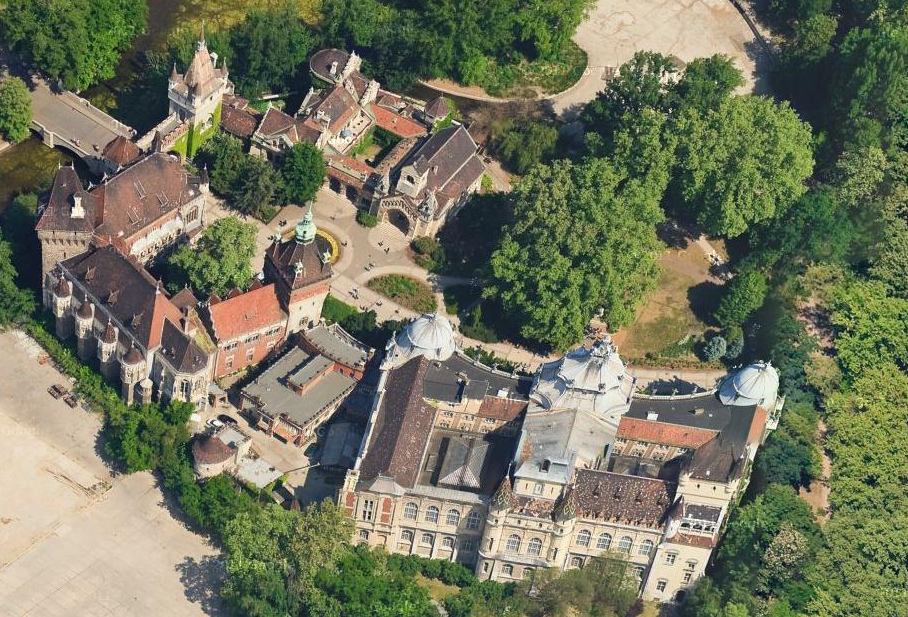
Vajdahunyad Castle with the Drained Lake on Google Maps (now refilled)
The main venue of the 1896 Millennial Expo of Budapest was the City Park (Varosliget). And if you expect to visit a Haunted Castle, facing the dark side of history with vampires, phantoms and ghosts, you will be slightly disappointed to learn that the castle is a friendly museum of agriculture, and has never been an actual royal or noble residence. But still a great place to visit! And let’s the history of the building.
Vajdahunyad Castle History
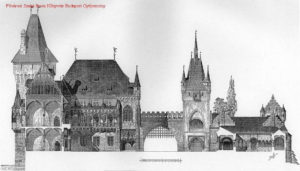
Design of Ignac Alpar Vajdahunyad Castle Budapest – Source- BudapestCityOrg
The whole nation was in a feverish preparation to celebrate the 1000th birthday, but, despite all hurried work, the Expo had to be held one year later (Hungarian astronomists set the date of the Magyar Conquest in 895, so the Exhibition was in fact the 1001th birthday).
The original building of the Vajdahunyad Castle (officially called in 1896 the Historical Building Complex, i.e. Tortenelmi Epuletcsoport) was just a temporary structure made of wooden planks and cardboard designs. Even its plain name was descriptive signifying that it is nothing more than a complex of various historical buildings. Ignac Alpar designed the building of Vajdahunyad Var, which is actually the name of an old Hungarian Gothic Castle in Hunyadvar hence Vajda-Hunyadvar (Hunyadvar was part of Austria-Hungary before 1919, now found in Romania).
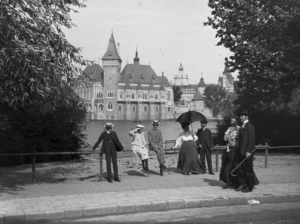
Vajdahunyad Castle Budapest in 1903 – Frigyes Schoch Photography (Fortepan)
But the Hungarians loved the building so much that it was eventually built from permanent materials (between 1904 and 1908), much to our great pleasure: now you can see stained windows, elaborately painted vaulted ceilings, marble staircases, etc.
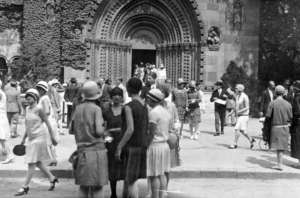
Jak Portal in Vajdahunyad Castle Budapest 1927 – Source- Fortepan
The name ‘Vajdahunyad Castle’ was not meant to stand for the whole building, but it was used so frequently by local residents – based on the most striking part of the complex – that the name Vajdahunyad Var eventually stayed with it.
The aim of building Vajdahunyad Castle was to showcase the beautiful and long history of the Magyars through its architectural treasures, picking some of the most outstanding buildings and details from all over Hungary (at that time part of the huge Austro-Hungarian Empire, which is significant in a sense that some of the buildings now you see in the showcase castle are outside the borders of Hungary)
Blending Styles in Vajdahunyad Castle
The concept of Vajdahunyad Castle Budapest was to blend the various architectural styles into one composite castle. The design of Ignac Alpar contains the architectural details of 21 buildings, some only in minor additions, while others as main characters.
The castle has three main parts architecturally:
Romanesque Middle Ages in Vajdahunyad Castle Budapest
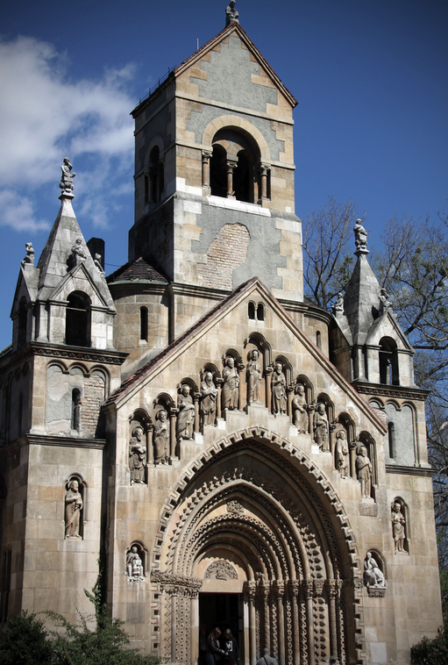
Vajdahunyad Castle Budapest, Romanesque Portal Jak – Kotomi Yamamura Photography
The oldest part of the Vajdahunyad Castle is the Romanesque style from the 11th – 13th century in Hungary. The Church of Jak village is located in western Hungary, near the Austrian border, and is in fact a huge basilica, which cannot be seen in the Vajdahunyad Castle where only the fascinating gate was copied rather than the whole building.
The Church of Jak was in fact the monumental basilica of the Benedictine monastery, most probably finished in 1256. The church was picked as the best representation of the Romanesque architecture in Hungary (somehow it managed to survive the many battles against the Ottoman Turks, the fires and other damages). The church in Jak was considerably restored in the late 19th century by Frigyes Schulek, the designer of the Fisherman’s Bastion (which was inspired by the Romanesque style).
The exact replica of the Portal of the Church of Jak shows the characteristic church gates of the 11th and 12th century, already blending in with the Gothic style where the portal was the main location for adding sculpted figures and images of the Bible.
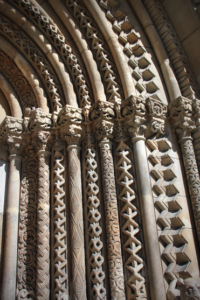
Vajdahunyad Castle Budapest, Romanesque Portal Jak – Kotomi Yamamura Photography2
You can see the elaborate carved Portal with narrowing ‘gates’ embedded into each other. This is the main gate of the church decorated with geometric Norman style motifs. Over the portal, you can see Jesus on the throne sided by two angels.
The tympanum over the portal shows the life size figures of the 12 apostles with Jesus. 2 of the apostles did only get place on the facade, outside the tympanum.
Next to the Portal, you can see the Madonna, and Samson’s fight with the lion.
The Chapel of Jak (Jaki kapolna) is extended with a medieval style ‘Kerengo’ cloister, which is beautiful and very romantic, well worth a visit.
Further parts of the Romanesque style building include the Auditory, the 37 meter tall Tower of Torture, the Tompa Tower, the Lion Bridge, the Bridge Gate (with mock bars, which cannot be closed), and the Bastion Tower of Segesvar.
The Chapel of Jak in Vajdahunyad Castle is not only an architectural replica, but a functioning Catholic chapel with religious ceremonies on Sundays from spring to autumn at 12 pm (noon), smaller weddings (of max 150 people), choir concerts, a small exhibition of the Romanesque style churches of Jak and Lebeny that gave the basis of building the Jaki Kapolna chapel in Vajdahunyad Castle. You can contact the Jak Chapel on Monday, Wednesday and Friday from 10-13 and 16-18 at the phone number 00-36-1-251-13-59. Weddings in Jak Chapel Budapest need to be booked 6 months in advance.
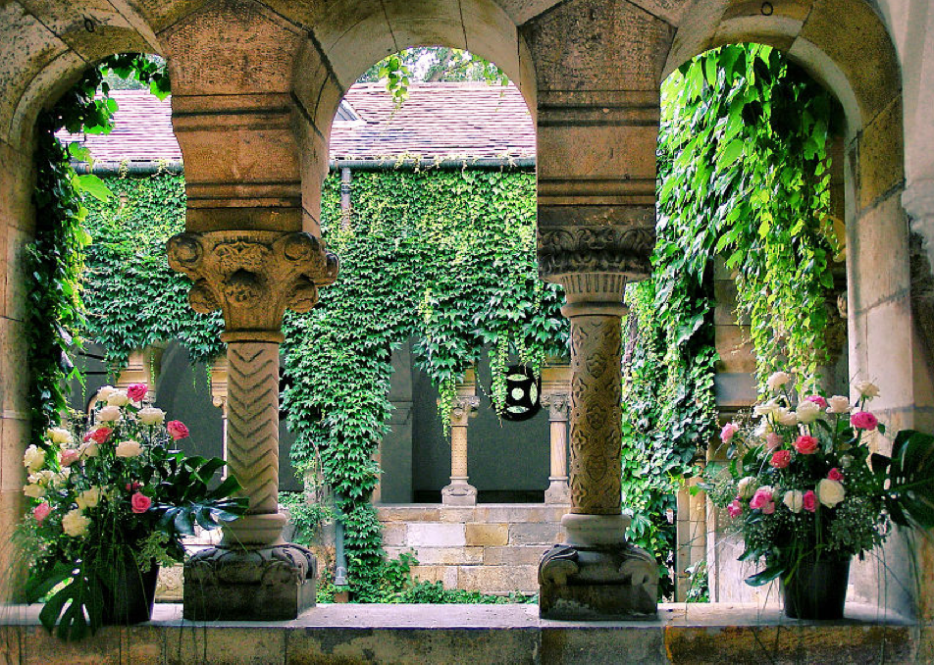
Romanesque Cloister, Vajdahunyad Castle Budapest – Kontiki Wikipedia Photo
Gothic Architecture in Vajdahunyad Castle Budapest
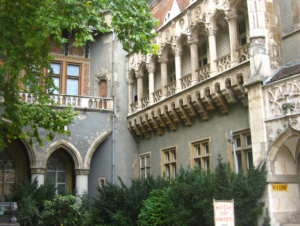
Gothic in Vajdahunyad Castle Varosliget Budapest – Kieran Lynam Photography
Then comes the Gothic age, the 14th -15th century, most stikingly represented by the Castle of Vajdahunyad, whose characteristic turrets and wooden beams strike the visitors as the leading theme. No wonder the whole structure of the castle has been named after the Gothic part – by the locals.
Vajdahunyad Castle, thought by many the home of Count Dracula, was once a part of the Hungarian state (the Austro-Hungarian Empire), called the King of Castles. Thus it was chosen in 1896 to represent the best example of Hungarian Gothic. Now if you look for it on the map, you need to google Hunedoara (Hunyadvar in Hungarian) to find it in Transylvania, Romania, where the magnificent historical castle stands on a rock soaring over the river Zlasti.
Hunyadi Family, Hunyadi Castle
The land where the castle was built was a gift from King Sigismund, Hungarian monarch to the grandfather of King Matthias, aka Matthias Hunyadi (whose Matthias Church you can see on the Buda Castle Hill) in 1409. King Matthias’ father, Janos Hunyadi erected the enormous and beautiful Gothic castle as a noble place for the knights, with tall, strong defense towers, drawbridge, Knights’ Hall, Capistrano Tower, Drummers’ Tower, etc.
The original Vajdahunyad Castle was probably the expanded version of the castle built by King Charles I of Hungary (known as the Corvin Castle) built on a previous fortification. He was a fine knight indeed, fighting the thousands of Turks attacking from the south to occupy Europe. It was his fights and knights that were encouraged by the papal decree to ring the Christian church bells at noon for defending Christendom.
That said, the original Vajdahunyad Castle (belonging to Romania since 1920, the Treaty of Trianon) must have been unbearably noisy with shrieks when John Hunyadi was torturing Turks, or other enemies, like Vlad the Impaler (who himself was named after the torturing technique he used with round headed oiled impaling rods).
Count Dracula in Vajdahunyad Castle
Was the creator of Count Dracula, the vampire lord indeed inspired by Vajdahunyad Castle? Did Bram Stoker visit the Castle? Who was Count Dracula, and did he reside in the castle or was he kept there? Can you meet Dracula in the Budapest Vajdahunyad Castle?
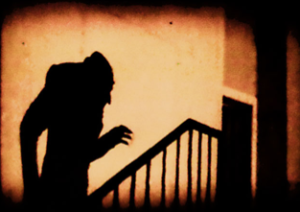
Shadow of Nosferatu – Source- Wikimedia
Dracula (almost titled The Undead) was published in 1897, inspiring thousands of films, including the Vampire Diaries or the Twilight saga, the vampire themed fantasy romance and horror comedy series. The manuscript now belongs to the co-founder of Microsoft.
Dracula’s character was most probably inspired by Vlad the Impaler, the 15th-century Transylvanian prince, also known as Vlad III Dracul of Wallachia, who was imprisoned by John Hunyadi in Vajdahunyad Castle for years. Besides keeping him behind bars, John Hunyadi was also said to have killed his father, Vlad II Dracul.
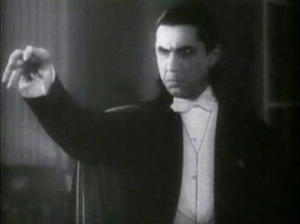
Bela Lugosi as Count Dracula – Source: Wikimedia
Bram Stoker pictured his Dracula living in the castle of Vajdahunyad, or maybe a similar castle somewhere in the dark and stark hills of Transylvania. What we know today is that before setting down to write his Dracula, Bram Stoker met Ármin Vámbéry, a Hungarian writer and traveler who shared dark stories of the Carpathian mountains with Stoker. Stoker, who was a skilled journalist, made Dracula the Vampire a 3D figure, putting believable diary entries, letters and even telegrams and newspaper clippings into his story. Nosferatu, the first silent film about Dracula came out as early as 1922, followed by the sound film in 1931, the Dracula starring the Hungarian actor, Bela Lugosi (who was buried in his Dracula cape in 1956).
See if you can find his bust in Vajdahunyad Castle Budapest.
Now the Gothic Building Complex within the Budapest Vajdahunyad Castle also include the following buildings from the 1896 Hungarian state (in addition to the Neboisa Tower, the Hunyadi Loggias, or the Knight’s Hall of the original Vajdahunyad Castle): the smaller replica of the Shrine of the Zapolya Chapel, Dome Facade, the Apostle Tower of the Segesvar Castle
Renaissance and Baroque in Vajdahunyad Castle Budapest
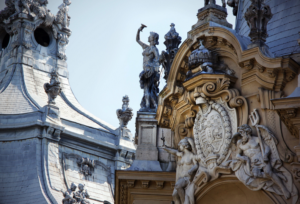
Baroque in Vajdahunyad Castle Budapest – Kotomi Yamamura Photography
The 16th – 18th century Renaissance and Baroque buildings are blended exquisitely, merging the elements of rich palaces in royal Hungary and Austria Hungary. The Baroque building is the main home of the Museum of Agriculture.
The Baroque palace is the replica of Austrian palaces in the Austro-Hungarian empire. The cupola over the main entrance was inspired by the Karoly Gate in Gyulafehervar. The Katalin Gate is from Brasov (Brasso in Hungarian, Kronstadt in German), with the balcony from the Town Hall of Bartfa. The German facade viewed from the lake reflects the German architectural style with sgrafittos, featuring the 50 meter tall German Tower topped with an onion dome (often found in Eastern Europe, Germany, Austria, Russia, etc. from eastern influences). The early French renaissance influence is shown on the French Tower with a dolphin atop.
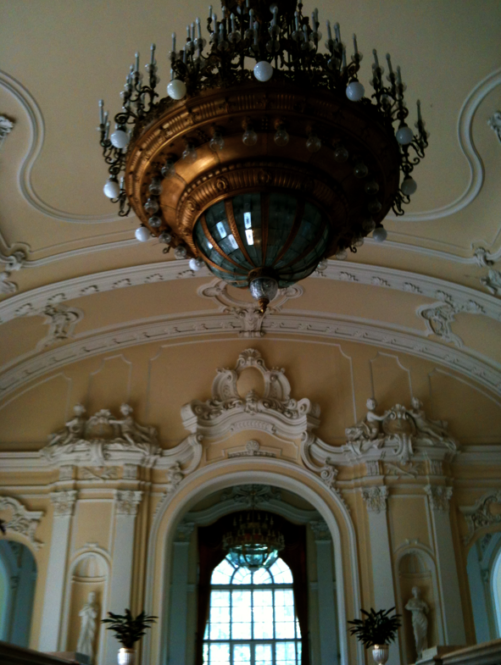
Baroque in Vajdahunyad Castle City Park Budapest – TopBudapestOrg Photography
Museum of Agriculture in Vajdahunyad Castle
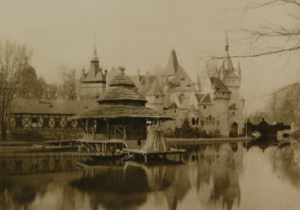
Hungarian Agricultural Museum in Vajdahunyad Castle
The building of Vajdahunyad Var in the City Park has always been the home of the Hungarian Agricultural Museum, since 1897. The Museum (Magyar Mezogazdasagi Muzeum) is in fact the biggest agricultural museum in Europe. There are 8 permanent exhibitions in the museum with detailed historical exhibits of the main aspects of agriculture, Wine Making, Fishing, Gardening, Animal Breeding, Forestry, Environmentalism, etc. and also an exhibition about the History of Hungarian Farming / Animal Husbandry. Permanent exhibitions are always on, extended by exhibits of temporary displays of various topics (e.g. Water, the Source of Life, or the History of the Legendary Hungarian Race Horse, Kincsem)
In addition to the exhibitions, the Museum hosts a wide range of cultural festivals (Carnival, Christmas Market), food fairs, wine events, concerts, children activities, etc.
The castle courtyards belong to the local Zuglo Municipality, District XIV of Budapest.
Vajdahunyad Castle in the City Park Budapest
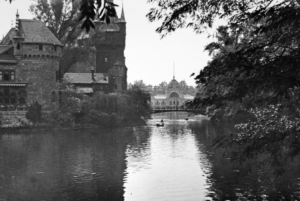
Boating Lake Vajdahunyad Castle Budapest 1930 – Source: Fortepan
Vajdahunyad Castle in Budapest is on a small island called Szechenyi Island, approached via a mock drawbridge over a shallow moat. The main entrance of the Castle is from the Heroes’ Square, and this gate is called the Bridge Gate (Hidaskapu) flanked by stone lions holding the coat of arms of Budapest.
The castle is surrounded by the water of the boating lake of the City Park (aka Varosliget). There are altogether four bridges leading to the Castle.
You can still rent boats by the Vajdahunyad Castle, the rental place is at the Pavilion, the building by the lake on the side of the Heroes’ Square.
The boating lake turns into a fantastic outdoor ice rink in winter time. From November till March you can enjoy a good skating on the biggest open air ice rink in Europe in a lovely romantic setting.
